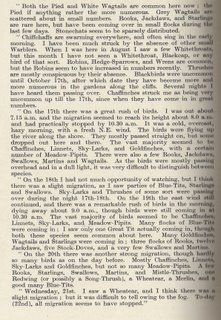 Two weeks after writing this, Monckton was killed in action, and became the first obituary in BB resulting from that stupid series of family tiffs between inbred Royal donkeys that was the Great War.
Two weeks after writing this, Monckton was killed in action, and became the first obituary in BB resulting from that stupid series of family tiffs between inbred Royal donkeys that was the Great War.The writer has lost in Monckton a valued and sincere friend and correspondent, and the study of Staffordshire Ornithology will suffer much by his having given his life so nobly for his country. (BB 8, 287)
Lewis N. G. Ramsay, 1890 - 1915.
Ornithologists have cause to mourn the loss of one most enthusiastic fellow worker who, though only 25 years old, had already much good work to his name... From an early age Mr Ramsay had been a keen student of birds and had amassed a great amount of data regarding the ornis of Aberdeenshire.
Lord Bradbourne, 1885-1915
..was killed at Neuve Chapelle on March 12th 1915. Lord Bradbourne had for some years been engaged in the study of South American birds, and at the time war broke out he was making collections of birds in Peru, whence he hurried home to rejoin his regiment.
Captain the Hon. Gerald Legge 1882-1915.
... was mortally wounded at Sulva Bay on September 9th 1915. All his life he was a keen naturalist, taking a special interest in wildfowl... As an instance of his keenness in studying ducks I may relate that one day when I met him at Patshullm he has just arrived from Northumberland, whence he had brought a nest of teal just hatching out. By telegraphing forward to several stations en route he had secured a relay of hot water bottles by means of which he had succeeded in keeping the ducklings warm.... He was last seen mortally wounded on the ground, and cheering on the men of whom he was so proud.
Major C. H. T. Whitehead 1881-1915
... was killed in action in France on September 25th or 26th, 1915. He was thirty-four years old... He discovered the new thrush, which I had the pleasure of naming Oreocincla whiteheadi after him, and amongst other interesting discoveries he made were the breeding haunts in the Himalayas of the Chinese Reed-Warbler.
Richard Bowen Woosnam 1880-1915.
..was killed while gallantly leading his men in an attack on the Turkish trenches in Gallipoli in June 4th,, 1915. Woosnam was an experienced traveller and field naturalist... All the collections he made are in the British Museum, and accounts of the birds with his field-notes have appeared in various volumes of the Ibis and the the Transactions of the Zoological Society.
Charles Stonham, 1859-1916
The ranks of British Ornithologists have been further thinned by the death of Charles Stonham... the brigade was duly mobilised at the outbreak of the present war, and in April 1915 Stonham proceeded to Egypt... and contracted the illness from the effects of which he came home to die... As a man, Stonham was a striking personality, tall of figure, lean and saturnine of appearance, of a fearless and outspoken honesty, and the possessor of a biting tongue: he hesitated not to speak of men and things as he found them: of enemies therefore he did not lack, nor did he of very many friends, and those of us who were privileged to know him well, knew him for a man of the kindliest nature, true as steel, and with a heart of pure gold.
Lieut. Col. H H Harington, 1868-1916
...who was killed in Mesopotamia on March 8th 1916. Colonel Harington was the discovery of a number of new forms, and several birds have been named after him in recognition of good work he did. He also contributed from time to time to the Ibis, the Journal of the Bombay Natural History Society and other periodicals.
Major F W Proctor, 1862 - 1916
...Almost to the last he retained his keen interest in oology and bird-life, and nothing gave him greater pleasure than the receipt of a letter full of bird news or a talk with a brother ornithologist.
Capt JM Charlton, 1881-1916 and Lieut HV Charlton, 1884-1916.
John Charlton was killed in the great attack near La Boiselle on July 1st 1916. He fell, shot through the head by a bullet, while leading his company....his last words being to his orderly: 'Is that you, B----? For God's sake, push on, I'm done.'...He supplied British Birds with a number of interesting notes and wrote many short articles in other journals and local papers. He was a most skilful and accurate taxidermist.
Hugh Charlton fell in action near Whychaate on June 24th 1916, struck by a bomb from a trench mortar... He also was a clever ornithologist and the brothers worked much together.... Birds were his speciality; his work was very artistic in nature.... One of his pictures, 'Home of the Dipper' was exhibited in the Royal Academy in 1912.
Capt. Cecil Stanley Meares, 1883 - 1916
... was killed while leading his company into action on July 30th 1916... He made, together with his brother DH Meares, an excellent scientific collection of British birds' eggs, which contained perfect clutches of eggs, of nearly every British breeding bird, supplemented by profuse and accurate data of their localities, notes and habits.... In his spare moments, even within sound of the guns, he would take walks and rides through the country to observe the bird life.
Captain Lord Lucas 1976-1916.
It was reported the Lord Lucas was missing after making a flight over German lines on November 4th, 1916... He was an ardent lover of Nature, and especially of birds, and was elected a member of the BOU in 1902. It may be mentioned that he took a considerable interest in our Marking Scheme, and only the other day we heard of an interesting record of the recovery of a Lapwing ringed by him some four years ago.
Frederick Courtney Selous 1842-1917
On one occasion, when grouse driving, Selous saw two Peregrine Falcons pass over, very high, mere specks in the air. None of the other six guns had noticed them; our gaze was presumably limited to the level of game flight. Selous scanned the whole arc of heaven... His very death - 'killed in action' at 65 - epitomizes his whole career.
Capt. John D. Grafton-Wignall, 1888-1917
... January 1916 saw him in Mesopotamia where, to the bitter regret of all who knew him, he was killed in action just over a year later... he had that perfect sight that enabled him to 'pick up' a sitting Woodcock or a clutch of shingle-laid eggs as quickly as (and he was quick) he could detect - and accurately name too - flying or at rest some bird a great way off... To his many friends - and to me especially - his loss is irreparable: ornithology has lost a very accurate, first-rate and indefatigable observer.
Eric B Dunlop, 1887-1917
The war has claimed as a victim in the person of Mr Eric B Dunlop, who was killed in action on May 19th, 1917, at the age of 30 years, one of the most promising young ornithologists in the north of England... He made a special study of the roosting habits of the Corvidae showing that the whole of the British members of this group congregated for roosting at certain seasons. ....At the outbreak of the war he was engaged upon a study of the nesting habits and incubation of birds and was in northen Manitoba, Canada... He was in France barely a month before his death.
Christopher James Alexander 1887-1917.
He was seriously wounded near Passchendaele on October 4th 1917, and it seems almost certain he was killed, or died after being put on the ambulance...
...Several letters followed from France, ending with one on September 30th in which he wrote of a Quail they had put up , which, with Pied Flycatcher, Woodchat and Melodious Warbler seen passing a few days before, made 107 species for the year - a wonderful total under such conditions. 'The sun is sinking into the mists' he concluded: 'it really looks quite wintry, in spite of the heat'. And then they went up to the line again...
... His work seemed hardly to have begun. But such as it is, all his work is methodical, scientific, accurate, full of insight and judgement, and, above all, the true expression of a life devoted to the study of Nature.
CJ Alexander was one brother of Horace Alexander (see 'Heroes') and this was written by him.
All these come from obituaries published in British Birds.

1 comment:
I got this one from Bob McGowan
In the 1916 Ibis, there is an obit for Captain E F Penn 4th Batt. Grenadier Guards who fell in action in Vermelles on 18 October 1915. One particular sentence reads ‘Capt. Penn was a keen sportsman and a fine shot, and was thus interested in birds.’
Post a Comment